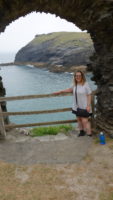 I needed to be the very model of a modern major tourist today, since I was in charge. We left the Dartmoor area, heading northwest toward the Cornish town of Tintagel, home of a ruined castle long rumored to be the birthplace (or at least the magical conception place) of King Arthur. Happily, although I had to leave Dartmoor behind, the ridiculously narrow roads continued, to where an oncoming car whose driver wouldn’t slow down or move over clipped my mirror, despite my being over as far as I could go and being nearly stopped. That was too close.
I needed to be the very model of a modern major tourist today, since I was in charge. We left the Dartmoor area, heading northwest toward the Cornish town of Tintagel, home of a ruined castle long rumored to be the birthplace (or at least the magical conception place) of King Arthur. Happily, although I had to leave Dartmoor behind, the ridiculously narrow roads continued, to where an oncoming car whose driver wouldn’t slow down or move over clipped my mirror, despite my being over as far as I could go and being nearly stopped. That was too close.
We did get to Tintagel safely, and pulled into the ever-present “pay and display” parking lot that doesn’t take credit cards. There was an older man in the lot packing up his truck, and I asked him where I could get change. He asked me what I was trying to change (a ten), and he actually walked a half block or so to his home to get the change for me. What a great guy.
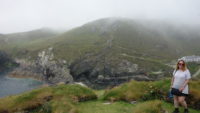 After breakfast at a pretty amazing bakery (Shannon will again note I had the best scone and clotted cream I’ve ever had), we walked out to the castle, which is dramatically on an (almost) island. It used to have a main part connected to a rear part, but the narrow neck of land between the two parts collapsed, leaving rubble between the two. It could be crossed, so it is not quite an island, but I was happy to use the modern steel bridge installed in 2019.
After breakfast at a pretty amazing bakery (Shannon will again note I had the best scone and clotted cream I’ve ever had), we walked out to the castle, which is dramatically on an (almost) island. It used to have a main part connected to a rear part, but the narrow neck of land between the two parts collapsed, leaving rubble between the two. It could be crossed, so it is not quite an island, but I was happy to use the modern steel bridge installed in 2019.
The day was sunny and fine as we explored the mainland part of the castle (a couple of rooms and walls). Right after we crossed the bridge, a thick fog started blowing in in bands. It was surprising, but atmospheric. Most of the mainland was eventually blotted out by fog. We clambered around paths and rocks and had a good time. There were the remains of fourth- or fifth-century structures (which is when Arthur would have lived if he did actually exist), but most of the castle was built in the 1200s, and was falling into disrepair just a little over a hundred years later. No one is quite sure why, but eventually the castle was fully abandoned. My guess is that it became too expensive for upkeep when the lord over the castle never actually visited it.
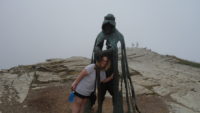 The is a cool and somewhat creepy statue of a man wearing a crown and holding a sword at the very top of the cliffs. It is called (in Cornish) Power, and in NO way could ever be in the slightest way misconstrued to be King Arthur. I happily took Meredith’s picture with King Arthur. Which reminded her that her parents had told her that for a time, they had been considering, if she had been a boy, naming him Arthur. They claimed not to have processed that his name, when read by last name, would have been “King, Arthur”; they said that what had dissuaded them was the fact that all of Carlene’s Mainer relatives would have called him “Ahthuh.”
The is a cool and somewhat creepy statue of a man wearing a crown and holding a sword at the very top of the cliffs. It is called (in Cornish) Power, and in NO way could ever be in the slightest way misconstrued to be King Arthur. I happily took Meredith’s picture with King Arthur. Which reminded her that her parents had told her that for a time, they had been considering, if she had been a boy, naming him Arthur. They claimed not to have processed that his name, when read by last name, would have been “King, Arthur”; they said that what had dissuaded them was the fact that all of Carlene’s Mainer relatives would have called him “Ahthuh.”
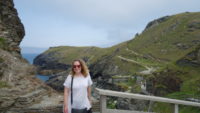 By the time we finished touring the upper island and descended to explore a path we had skipped, the fog had cleared, and we had good views again. So we had the best of both worlds. We took the older entrance path back, which is down one hundred steps, but has great views of the coast and the new bridge. We walked the half mile back up (and up and up) to town, made a quick second stop at our new favorite bakery, and headed southwest toward the southern coast town of St. Mawes.
By the time we finished touring the upper island and descended to explore a path we had skipped, the fog had cleared, and we had good views again. So we had the best of both worlds. We took the older entrance path back, which is down one hundred steps, but has great views of the coast and the new bridge. We walked the half mile back up (and up and up) to town, made a quick second stop at our new favorite bakery, and headed southwest toward the southern coast town of St. Mawes.
St. Mawes is on a peninsula, so it took a little time to get out there and then again to get back from there, but I wanted to see the fort there. We’d bought a sixteen-day English Heritage card, which gets us in for free at any Heritage site, and there are over four hundred of them (many are free for everyone). St. Mawes was touted as the castle with the prettiest setting, and it was (sort of) on the way to our inn near Penzance, and it was free for us.
 It turned out to be a good decision. The fort was never besieged, so it is in good shape. It was built by Henry VIII, so is “only” about 475 years old, and it is indeed in a pretty place, on the wide mouth of the Carrick Roads, which is large waterway that connects to Truro (an important town of the time). As an added visual bonus, the “bay” was full of sailboats. The docent wasn’t sure why, but felt there was something maritime-related going on in the nearby town of Falmouth. They were elegant.
It turned out to be a good decision. The fort was never besieged, so it is in good shape. It was built by Henry VIII, so is “only” about 475 years old, and it is indeed in a pretty place, on the wide mouth of the Carrick Roads, which is large waterway that connects to Truro (an important town of the time). As an added visual bonus, the “bay” was full of sailboats. The docent wasn’t sure why, but felt there was something maritime-related going on in the nearby town of Falmouth. They were elegant.
All four floors of the fort were open to visitors, as well as the main grounds in front of the fort, where later and larger cannons were installed, as well as a main powder magazine. Mer loved the letter on display in the fort of the captain politely reminding King Henry’s court that the fort had been promised shot and powder, and maybe, just maybe, if it wasn’t too much trouble, they might do a better job of defending the fort with said shot and powder. Mer said she recognized the type of letter of a subordinate politely asking for material needed to actually do a job.
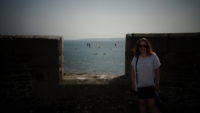 At 5:00, we headed to our inn, but it took about thirty minutes just to backtrack off the peninsula. We got to our inn around 6:30, got checked in, and had supper, and because the next two days are calling for difficult weather (rain and winds up to fifty mph), I drove us into Penzance to see it in the sun.
At 5:00, we headed to our inn, but it took about thirty minutes just to backtrack off the peninsula. We got to our inn around 6:30, got checked in, and had supper, and because the next two days are calling for difficult weather (rain and winds up to fifty mph), I drove us into Penzance to see it in the sun.
Gilbert and Sullivan notwithstanding, it turns out that Penzance isn’t so cute as I thought it would be. Most of the businesses were already shuttered at 8:00 on a Friday, and very few people were out. The town does have an awesome 1930s art-deco saltwater sea pool that is huge, and it has a cool island with a monastery sitting on it in the bay, but that seemed to be about all it had going for it tonight. And we got splatted by seagull shrapnel. Ew. We drove back to our room, getting in a little after 9:00.
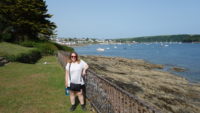 Cornwall was the seed of this trip to England, since we had watched all of the TV show Poldark which is set here. I deliberately wanted to be here three days, and Mer wanted one day, so that we might maximize the chance for good weather. Today was great, and Monday looks fine, but the next two days will present modern major challenges with the weather.
Cornwall was the seed of this trip to England, since we had watched all of the TV show Poldark which is set here. I deliberately wanted to be here three days, and Mer wanted one day, so that we might maximize the chance for good weather. Today was great, and Monday looks fine, but the next two days will present modern major challenges with the weather.
In Tintagel, you missed visiting Camelot, the hotel run by the self-proclaimed “world’s greatest living artist”. It’s a special place. Chosen by Jo…